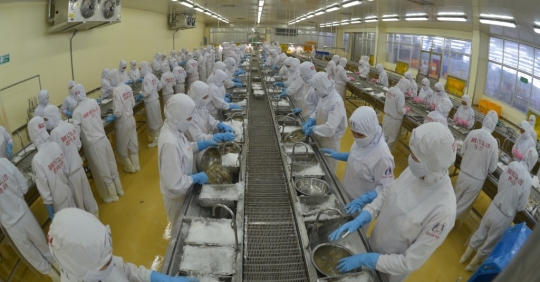At the Vietnam Shrimp Production, Processing and Export Linking Forum held in Ho Chi Minh City on July 21, Mr. Ngo The Anh, head of Aquaculture Department (Department of Fisheries, Ministry of Agriculture and Rural Development) of the shrimp industry has played an important role in Vietnam’s seafood exports over the past two decades.
At present, Vietnamese shrimp are exported to about 100 countries and areas, with five main markets including Europe, the United States, Japan, China and Korea. Vietnam has become the second largest shrimp supplier in the world, with export value accounting for 13-14% of the world’s total shrimp export value.

Mr. Ngo The Anh, head of Aquaculture Department (Department of Fisheries, Ministry of Agriculture and Rural Development), said Vietnamese shrimp are currently exported to about 100 countries and territories. Picture: Minh Sang.
Each year, the shrimp industry contributes about 40-45% of the total seafood export value, which is US$3.5-4 billion. Our country’s shrimp export turnover also set a record in 2022, reaching US$4.3 billion, up 11.2% compared with 2021.
According to Mr. The Anh, over the past 5 years (2018-2022), the shrimp industry has maintained a relatively stable farming area of more than 700,000 hectares developed in some transitional (salinity) areas. The level of intensive farming/application of science and technology and new agricultural technologies in production is concentrated but not high; was not active in seed sources and still relies on natural and imported sources. The links in the shrimp chain are still loose, production costs high, competitiveness low…
The ANH also said that in the first 6 months of 2023, the whole country’s brackish shrimp farming area reached 656,000 hectares, up 6.4% from the same period last year, of which the area of black tiger shrimp was 605,000 hectares and shrimp. White Leg Card 51,000 hectares. The country’s brackish shrimp production reached 467,000 tons, up 4.1% from the same period in 2022.
However, the shrimp export turnover only reached US$1.56 billion, accounting for 38% of the country’s total seafood export turnover. Although the area and production of shrimp were on schedule and growing compared to the same period in 2022, export sales fell, the season was good, but the selling price fell sharply and input costs were high.
Currently, the shrimp industry is facing difficulties and challenges such as climate change and drought – the salinity in the Mekong Delta fluctuates unpredictably, bringing with it the risk of disease outbreaks. The seed source is not active, dependent on imports and natural exploitation, so it is difficult to control the quality.
The infrastructure of the agricultural area is not guaranteed and small and fragmented productions still make up the majority. The linking of production and export chains is not tight and effective. Monitoring and warning of the agricultural environment is still insufficient. In particular, high production costs, low competitiveness.

The shrimp industry has played an important role in Vietnam’s seafood exports over the past two decades. Picture: Thanh Cuong.
Regarding the development orientation of the brackish shrimp industry in the coming period, Mr. The Anh shared that he will focus on applying new and advanced techniques in production, diversifying breeding methods according to the conditions of each region, and adapting to the impact of climate change.
For the coastal provinces from Quang Ninh to Thua Thien Hue, priority should be given to the development of temperature-controlled winter farming methods, intensive farming and super-intensive farming in net houses, cement tanks and canvas-lined ponds.
For the southwestern coastal provinces, priority should be given to the development of organic mangrove black tiger shrimp farming, organic farming and shrimp rice farming. Applying science and technology to improve shrimp productivity in extensive farming areas.
As planned, in the last 6 months of 2023, the shrimp industry will focus on maintaining the breeding area and supplementing the harvesting area. Specifically, production is targeted at 563,000 tons in the last 6 months of 2023.
The shrimp industry has proposed solutions to ensure production in the last months of 2023, such as: maintaining production, stabilizing the psyche of farmers, no mass harvest. Technical guidance adapted to the current conditions and context towards reduction of stocking densities, large harvest volumes combined with solutions to reduce input costs…
At the same time, focus on urgent solutions such as: reducing intermediate costs, feed, input materials, reducing product costs to maintain production and ensure the annual plan…

